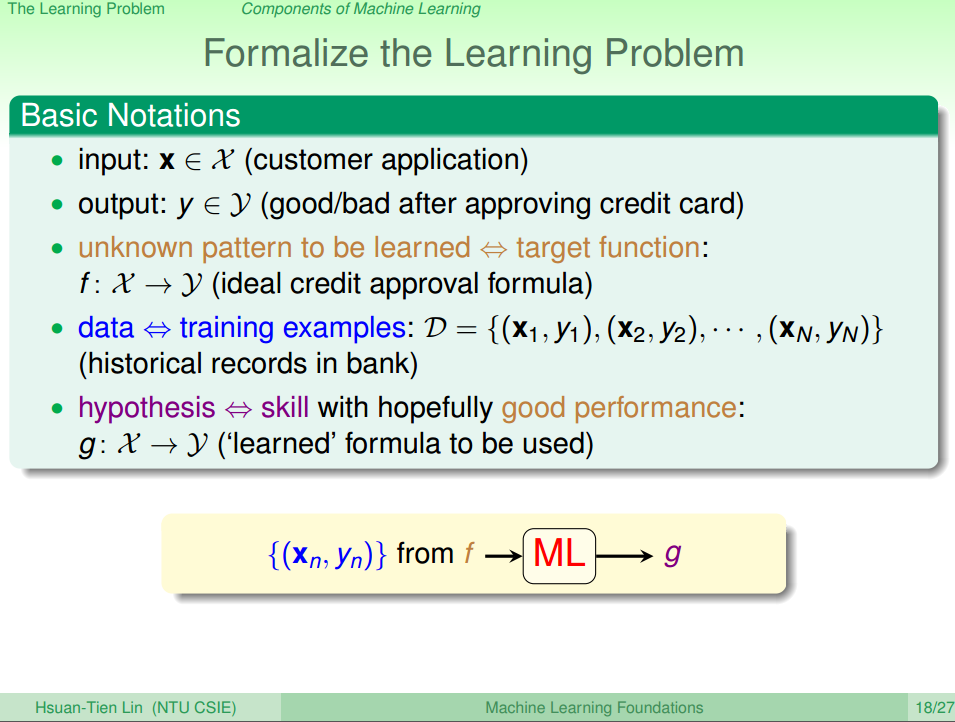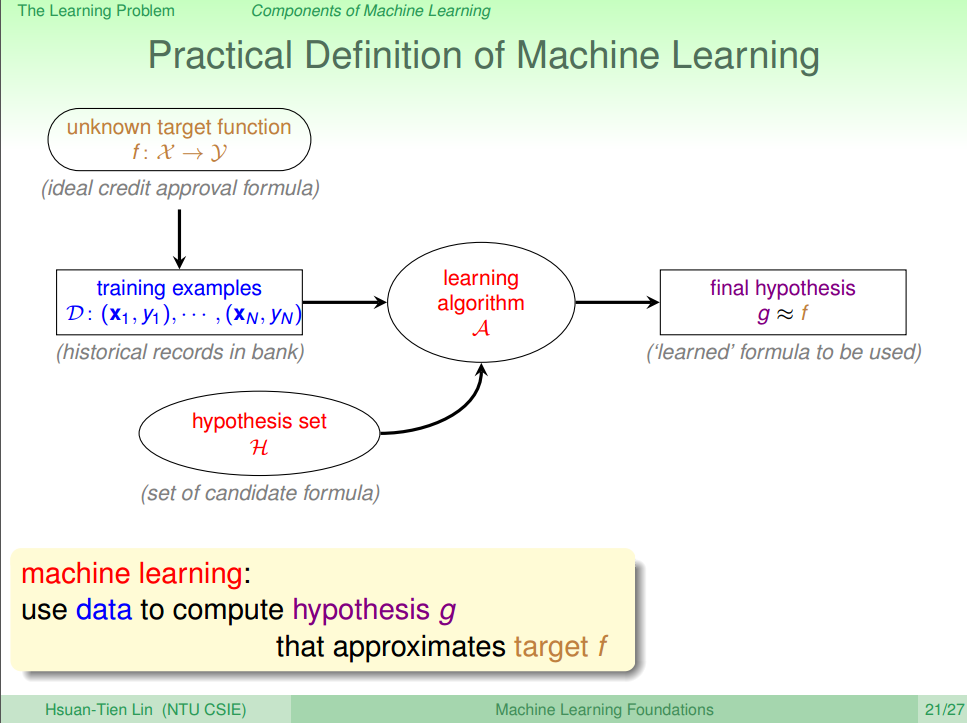1. 机器学习基石-When can Machine Learn?
来源:互联网 发布:程序员为什么工资高 编辑:程序博客网 时间:2024/05/16 05:04
When can Machine Learn? - The Learning Problem
- When can Machine Learn? - The Learning Problem
- 1. The Learning Problem
- 1) Human Learning and Machine Learning
- ① Human Learning
- ② Machine Learning
- ③ Summary
- 2) Human Learning V.S. Machine Learning
- 3) Key to Machine Learning
- 1) Human Learning and Machine Learning
- 2. Application of Machine Learning
- 3. Components of Machine Learning
- 1) Basic Notation
- 2) Practical Definition
- 4. Machine Learning and Other Fields
- 1) Machine Learning V.S. Data Mining
- 2) Machine Learning V.S. Artificial Intelligence
- 3) Machine Learning V.S. Statistic
- 1. The Learning Problem
- Summary
- Reference
1. The Learning Problem
To figure this out, we need to compare Human Learning and Machine Learning.
1) Human Learning and Machine Learning
① Human Learning
Human learning means people learn from perception (E.g., observation, touching, hearing).
② Machine Learning
Like human learning, machine learning means that machine learn things by collecting data, then computing the data to get skills.
③ Summary

2) Human Learning V.S. Machine Learning
既然人类和机器学习的过程一样,为什么我们还要耗费精力去让机器可以学习呢?
- 一些数据或者信息,人类难以识别;
- 学习的数据量特别大,人脑难以处理
- 人脑处理问题的速度很慢,但是很多情况下要求系统能快速的给出答案
总结如下表:
3) Key to Machine Learning
不是所以情况都可以使用机器学习,必须满足一下3个关键条件:
- 存在一个模型,能让我们对它进行改进。(不需要改进,就不需要进行ML了)
- 规则不容易找出。(如果太简单的话,用ML反而使得其反,耗费了人力物力)
- 需要有数据的支持,且数据量理论上越大越好。(这给机器学习提供了保证,后面会介绍)
2. Application of Machine Learning
Machine Learning actually can apply to everything.
E.g.,
- Daily need
- Food
- How does the food taste?
- How many chances that some specific people will like the food?
- …
- Clothing
- The information of the clothing.
- Fashion recommendation
- …
- Housing
- Energy load
- Sell price
- …
- Transportation
- Driving automation
- Transportation times
- Traffic jam possibilities
- …
- Food
- Education
- Math tutoring system.
- Quiz generator
- …
- Entertaining
- Recommendation system
- Real view experiencing of traveling
3. Components of Machine Learning
以银行是否应该对客户发放信用卡作为例子
1) Basic Notation

1.输入(input):
2.输出(output):
3.未知的函数,即目标函数(target function):
4.数据或者叫做资料( data),即训练样本( training examples):
5.假设(hypothesis),根据训练样本得到的实际的函数:
2) Practical Definition

机器学习算法(learning algorithm)一般用
4. Machine Learning and Other Fields
Machine Learning VS Data Mining, Artificial Intelligence, Statistic
1) Machine Learning V.S. Data Mining
机器学习与数据挖掘都叫知识发现(KDD Knowledge Discovery in Dataset)。
- 两者是一致的:能够找出的有用信息就是我们要求得的近似目标函数的假设。
- 两者是互助的:ML需要大数据的支持才能保持能“学到东西”。
- 数据挖掘更关注于从大量的数据中的计算问题。
总的来时,两者密不可分。
2) Machine Learning V.S. Artificial Intelligence
AI是通过特定的方法让机器能做出Intelligent的行为,ML属于AI的一个分支,是AI实现的一种方式
3) Machine Learning V.S. Statistic
统计是通过对已知数据的处理,从而推断出未知的事件的属性
所以统计学是实现ML的一种方法,统计学里面有许多实用的工具可以用于证明ML。
Summary
- 机器学习类似于人类的学习
- 机器学习的应用很广,可以说应用领域是各行各业
- 机器学习包含:输入数据,输出结果,目标函数,假设函数 ,数据集
- 机器学习ML与AI,DM, Statistics有关系, ML∈AI, ML≈DM, ML使用Statistics
Reference
[1]机器学习基石(台湾大学-林轩田)\1\1 - 4 - Components of Machine Learning (11-45)
- 1. 机器学习基石-When can Machine Learn?
- 2. 机器学习基石-When can Machine Learn?
- 3. 机器学习基石-When can Machine Learn?
- 4. 机器学习基石-When can Machine Learn?
- 5. 机器学习基石-Why can Machine Learn?
- 6. 机器学习基石-Why can Machine Learn?
- 7. 机器学习基石-How can Machine Learn?
- 8. 机器学习基石-How can Machine Learn?
- 9. 机器学习基石-How can Machine Learn?
- 10. 机器学习基石-How can Machine Learn?
- 12. 机器学习基石-How can Machine Learn Better?
- 13. 机器学习基石-How can Machine Learn Better?
- 14. 机器学习基石-How can Machine Learn Better?
- 机器学习基石-Dual Support Vector Machine
- NTU-Coursera机器学习:机器学习基石 (Machine Learning Foundations)
- 机器学习基石第二讲:learn to answer yes/no
- 林轩田之机器学习课程笔记(when can machines learn之learning problem)(32之1)
- 林轩田之机器学习课程笔记(when can machines learn之types of learning)(32之3)
- 线性表
- 2674-学生成绩统计
- 史上最全的iOS之UITextView实现placeHolder占位文字的N种方法
- 【XML】C#中XML文件增删改查简单应用
- 2675-静态数据成员与静态成员函数
- 1. 机器学习基石-When can Machine Learn?
- [Golang学习]Ubuntu搭建Go语言开发环境
- windows 10 下安装weex-toolkit
- C++ Primer 中文版(第5版) 习题答案
- 《Win32多线程程序设计》CRT中的多线程
- IOS ——地图里NSString转为CLLocationDegrees类型
- [lcm] Qualcomm平台的显示屏lcd驱动移植步骤
- LeetCode简易题解--053
- vector set_union() /set_intersection【集合合并/交集】


